The Philippine Statistics Authority, National Capital Region – Provincial Statistical Office II (Quezon City and City of Marikina) in celebration of Women’s Month every March issues a Special Release on Women and Men in Quezon City.
This special release presents information through analysis, charts, and tables gender-disaggregated data taken from the 2020 Census of Population and Housing (CPH) results of the Philippine Statistics Authority (PSA).
Household population comprises over 99 percent of the total population
Based on the 2020 Census of Population and Housing (CPH), Quezon City had a total population of 2,960,048 persons. Of this total, the household population or the population enumerated in private households during the census comprised 2,950,493 (99.7%) persons.
Of the household population in 2020, females accounted for 50.3 percent while males accounted for the remaining 49.7 percent. By age group, there were 398.7 thousand females and 427.3 thousand males aged below 15 years old (young dependents). Females aged 15 to 64 years (working age or economically active population) totaled to 1.0 million, while those in age group 65 years and over (old dependents) comprised about 84.9 thousand. On the other hand, males aged 15 to 64 years and 65 years and above accounted for 982.8 thousand and 55.4 thousand, respectively. (Figure 1, Table 1 and 8)
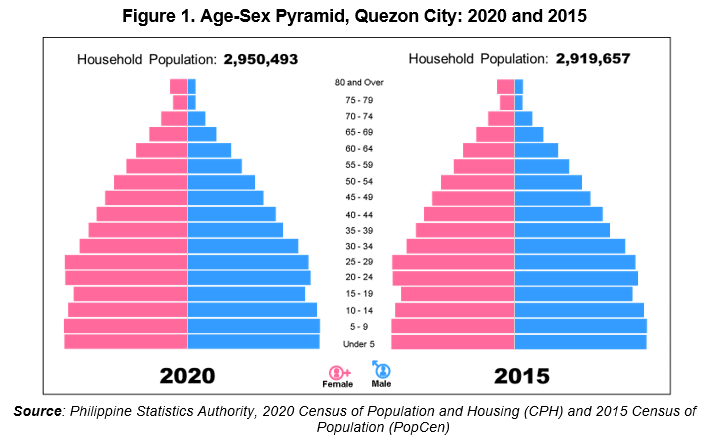
More females than males in Quezon City
Quezon City registered a sex ratio of 99, in 2020. This means that there were 99 males for every 100 females, a slight increase compared to 97 males per 100 females sex ratio in 2015.
Population aged below 15 years had a sex ratio of 107 males per 100 females. Moreover, among those aged 65 years and over, the sex ratio was 65 males per 100 females. This shows a longer life expectancy among females than male or higher mortality rate among males than females in the older age group. (Figure 2, and Table 2)
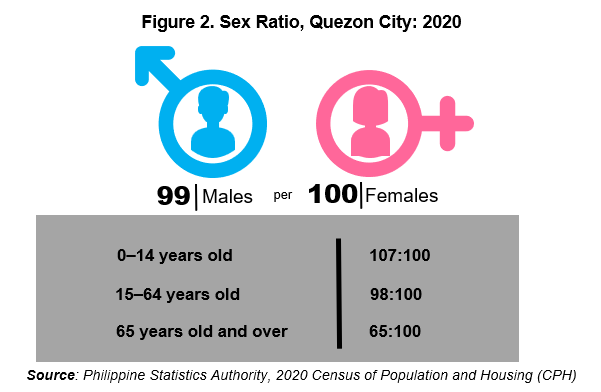
Overall age dependency ratio increases to 49 dependents
The overall age dependency ratio in Quezon City was computed at 49, which indicates that for every 100 working-age or economically active population, there were about 49 dependents (42 young dependents and 7 old dependents). This is higher than the dependency ratio in 2015, which was recorded at 44 dependents (38 young dependents and 6 old dependents).
Age dependency ratio in female population was slightly lower at 48 (40 young dependents and 8 old dependents) than that of males at 49 (43 young dependents and 6 old dependents). In 2015, age dependency ratios of female and male population were at 43 (36 young dependents and 7 old dependents) and 46 (41 young dependents and 5 old dependents), respectively. (Figure 3, and Table 3)
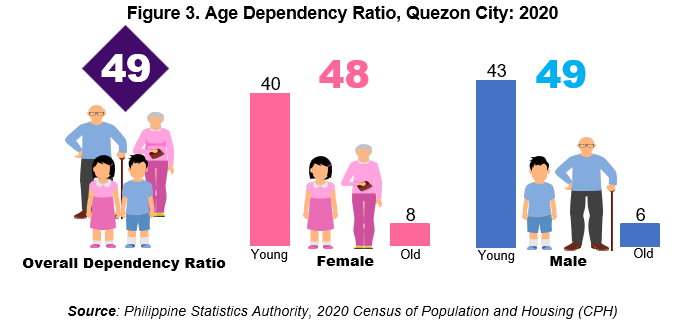
Children below 5 years old account for almost 10 percent of the household population
Children below 5 years old were recorded at 291.1 thousand. This number comprised 9.9 percent of the household population in 2020 and is 11.9 percent higher compared to 260.1 thousand count in 2015.
Female household population aged below 5 years old went up by 12.9 percent from 125.0 thousand in 2015 to 141.2 thousand in 2020. The same trend was also observed with males recorded an 11.0 percent increase from 135.2 thousand to 150.0 thousand in 2015 and 2020, respectively. (Figure 4, and Table 4)
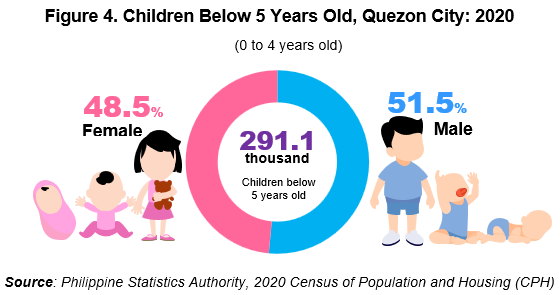
School age population decrease for both female and male
In 2020, the school age population (5 to 24 years old) of Quezon City was lower than it was in 2015. It was recorded at almost 1.1 million or 35.6 percent of the household population compared to over 1.1 million or 38.4 percent that was reported in 2015.
There were 513.7 thousand (48.9%) females, not as much as 536.7 thousand (51.1%) males in the age group 5 to 24 years. The same trend was observed in 2015, where females were exceeded by males in terms of number in the same age group with 557.2 thousand (49.7%) and 564.3 thousand (50.3%), respectively. (Figure 5, and Table 5)
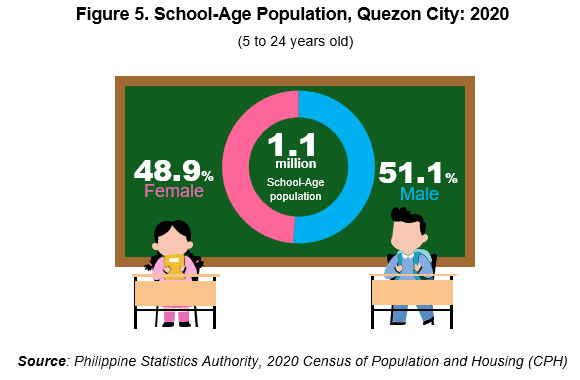
Senior citizens account for 8.0 percent of the household population
Senior citizens are those persons aged 60 years old and over. In 2020, there were a total of 234.7 thousand senior citizens or 8.0 percent of the household population in Quezon City. This number was 39.2 thousand or 20.1 percent higher than 195.4 thousand in 2015.
Female senior citizens were significantly higher than that of males with 136.5 thousand (58.2%) and 98.2 thousand (41.8%), respectively. The same trend was observed in 2015. (Figure 6, and Table 6)
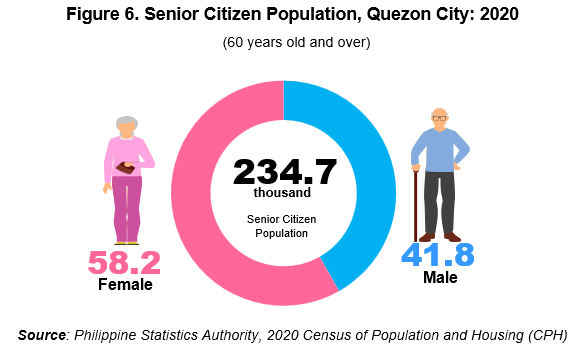
3 in every 5 females belong to the women of reproductive age group
Women of reproductive age (15 to 49 years old) totaled to 809.6 thousand or 54.5 percent of the 1.5 million female household population, in 2020. However, this figure represents a decline from the 862.2 thousand or 58.2 percent posted in 2015. (Figure 7, and Table 7)
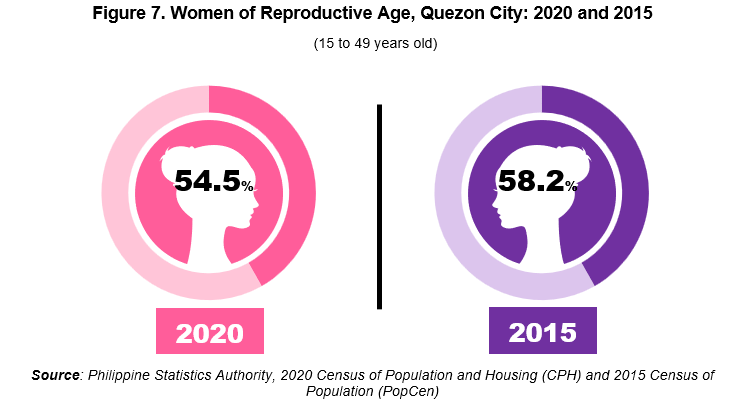
EXPLANATORY NOTE
March of every year is celebrated as the National Women’s Month to highlight women’s achievements and discuss continuing equality issues and concerns, challenges, and commitments. A call to action for everyone, regardless of gender, to work together towards creating a more inclusive and equitable future for all.
CONCEPTS AND DEFINITIONS
Population Census refers to the total process of collecting, compiling, evaluating, analyzing, and publishing demographic, economic and social data pertaining to all persons in the country or in a well-limited territory.
Total Population refers to the sum of the household population and institutional population. It also includes Filipinos in Philippine embassies, consulates, and missions abroad.
Household Population comprises of persons who belong to a household, the basic criterion of which is the usual place of residence or the place where the person usually resides.
Household is a social unit consisting of a person living alone or a group of persons who sleep in the same housing unit and have a common arrangement in the preparation and consumption of food.
Sex ratio is the ratio of males to females in a given population, expressed as the number of males per 100 females.
Age is the interval of time between a person’s date of birth and the census reference date (1 August 2015 and 1 May 2020). Expressed in completed years (as of last birthday), it is recorded in whole number.
Overall Dependency Ratio refers to the ratio of persons in the dependent ages (under 15 years old and over 64 years old) to persons in the economically active or working ages (15 to 64 years old) in the population.
School Age Population refers to population from age 5 to 24 and irrespective of the existing requirements of compulsory education or the period of education provided for in various types of schools.
Senior Citizen refers to an individual aged 60 years old and above.
Women of Reproductive Age refers to all women aged 15–49 who are at risk of pregnancy.
(SGD) APOLINAR F. OBLEA
Chief Statistical Specialist
